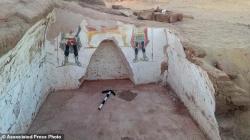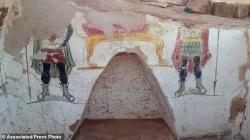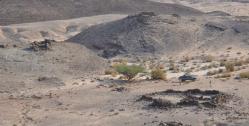INSTITUT SUPERIEUR D'ANTHROPOLOGIE
INSTITUTE OF ANTHROPOLOGY
ONLINE COURSES / COURS A DISTANCE
WINTER TERM : JANUARY 2019
REGISTER NOW
ROYAUME UNI –  – Cupar - The discovery of what appears to be a Bronze Age cremation pit under the centre of Cupar has been hailed as an archaeological find of national importance. Cremated bone was uncovered during the final day of a community excavation at East Moat Hill involving volunteers and experts. The remains were radiocarbon dated and found to be 4,000 years old. There is already evidence that the area was a place of medieval assembly, where open-air councils were held and justice dispensed, until the 15th Century but the findings have revealed its earlier significance. Coins, metal objects, a gunflint and a .303 cartridge were among other discoveries from the 17th to 20th centuries made during the dig in October. Alastair Rees of ARCHAS Archaeology said: “The very last day of the excavation revealed some interesting deposits on the summit of the hill. “A large, deep pit was revealed and a small investigative trench was excavated into this feature. “At the base of the pit, a small cremation deposit was located.” He said his team was able to extract a small sample of the cremated bone which has been radiocarbon dated to approximately 1750BC, roughly the transition from the Early to the Middle Bronze Age, nearly 4,000 years ago.
– Cupar - The discovery of what appears to be a Bronze Age cremation pit under the centre of Cupar has been hailed as an archaeological find of national importance. Cremated bone was uncovered during the final day of a community excavation at East Moat Hill involving volunteers and experts. The remains were radiocarbon dated and found to be 4,000 years old. There is already evidence that the area was a place of medieval assembly, where open-air councils were held and justice dispensed, until the 15th Century but the findings have revealed its earlier significance. Coins, metal objects, a gunflint and a .303 cartridge were among other discoveries from the 17th to 20th centuries made during the dig in October. Alastair Rees of ARCHAS Archaeology said: “The very last day of the excavation revealed some interesting deposits on the summit of the hill. “A large, deep pit was revealed and a small investigative trench was excavated into this feature. “At the base of the pit, a small cremation deposit was located.” He said his team was able to extract a small sample of the cremated bone which has been radiocarbon dated to approximately 1750BC, roughly the transition from the Early to the Middle Bronze Age, nearly 4,000 years ago.
https://www.thecourier.co.uk/fp/news/local/fife/806837/bronze-age-find-in-cupar-hailed-of-national-importance/
EGYPTE – 
 Beir Al-Shaghala - Egypt says archaeologists have uncovered two ancient tombs dating back to the Roman period in the country's Western Desert. The Antiquities Ministry says Tuesday the excavations took place in the Beir Al-Shaghala archaeological site in the Dakhla Oasis. Mostafa Waziri, secretary general of the Supreme Council of Antiquities, says the tombs were built in mud-brick with different architectural styles. He says archaeologists uncovered ancient human remains and pottery fragments inside the tombs. They also found colorful funeral paintings on the walls of both tombs.
Beir Al-Shaghala - Egypt says archaeologists have uncovered two ancient tombs dating back to the Roman period in the country's Western Desert. The Antiquities Ministry says Tuesday the excavations took place in the Beir Al-Shaghala archaeological site in the Dakhla Oasis. Mostafa Waziri, secretary general of the Supreme Council of Antiquities, says the tombs were built in mud-brick with different architectural styles. He says archaeologists uncovered ancient human remains and pottery fragments inside the tombs. They also found colorful funeral paintings on the walls of both tombs.
https://www.dailymail.co.uk/wires/ap/article-6594019/Archaeologists-Rome-era-tombs-Egypts-Western-Desert.html
CHINE - Huarong - Archaeologists have said they have identified a large Neolithic settlement site complete with defensive walls and ditches in central China's Hunan Province. The 25-hectare Qixingdun Site, discovered in Huarong County, was built around 3,000 B.C. and was in use until 2,000 B.C., said Wang Liangzhi, leader of the excavation team from Hunan Provincial Institute of Archaeology. Wang said the settlement's double-circle and ditch structures were rare in the midstream region of the Yangtze River of that time. Its walls, constructed in a manner yet to be understood, were found to have multiple materials, unlike other city walls in China that used a single material. Experts also said the settlement was abandoned later than most others in the Yangtze midstream region, providing insight into the social evolution of the region. Excavation of the site, discovered in 1985, began last year. Its name, meaning "Seven-Star Mounds," comes from the seven mounds found above the site. Articles excavated from the site include pottery and stone tools as well as carbonized rice.
http://www.china.org.cn/arts/2019-01/15/content_74374205.htm
CHINE –  Jalainur - A carbon-14 dating study on four skull samples discovered in the Jalainur district of Manzhouli in the Inner Mongolia autonomous region confirmed that the oldest dated to about 10,113 years ago. The other three were found to be 7,400 years, 1,600 years and 1,000 years old, Wu Xiaohong of Peking University's school of archaeology and museology, told a news conference in Beijing."These findings prove that humans had lived in the Jalainur area for 10,000 years," said Wu, a team member involved in the study. The study, which began in March, was conducted by researchers from Peking University and the archaeology school at Jilin University. Jalainur, a county-level district under the jurisdiction of Manzhouli, is located near Russia and Mongolia. It is believed to be the origin of the prairie culture of northern China. Historical records show that major northern clans, including Xiongnu, Xianbei and Khitan, once lived there. The first Jalainur skull was found in 1933 by coal miners digging in an open pit. By 1996, 22 such skulls had been discovered. Because most of these human skulls were not excavated by professional archaeologists from the original formations in which they were found, it was hard to determine exactly how old they were, said Zhu Hong, a team member from Jilin University. The carbon-14 study has settled the dating problem, and the results and the pottery ruins unearthed there prove that Jalainur people lived in the Neolithic Age at least 10,000 years ago, Zhu said. Wang Wei, president of the Chinese Society of Archaeology, said the Jalainur skulls were found at the highest latitude in China, adding that stone tool making skills had become relatively mature by the time these individuals lived. "They had learned to turn stones into slim blades and bind them onto bone tools as knife edges for cutting animals," said Wang, adding such skills were the most advanced in the world at that time. Zhu of Jilin University said a physical anthropology study was also undertaken, analyzing the DNA data of the Jalainur skulls. Results will be announced later, he said.
Jalainur - A carbon-14 dating study on four skull samples discovered in the Jalainur district of Manzhouli in the Inner Mongolia autonomous region confirmed that the oldest dated to about 10,113 years ago. The other three were found to be 7,400 years, 1,600 years and 1,000 years old, Wu Xiaohong of Peking University's school of archaeology and museology, told a news conference in Beijing."These findings prove that humans had lived in the Jalainur area for 10,000 years," said Wu, a team member involved in the study. The study, which began in March, was conducted by researchers from Peking University and the archaeology school at Jilin University. Jalainur, a county-level district under the jurisdiction of Manzhouli, is located near Russia and Mongolia. It is believed to be the origin of the prairie culture of northern China. Historical records show that major northern clans, including Xiongnu, Xianbei and Khitan, once lived there. The first Jalainur skull was found in 1933 by coal miners digging in an open pit. By 1996, 22 such skulls had been discovered. Because most of these human skulls were not excavated by professional archaeologists from the original formations in which they were found, it was hard to determine exactly how old they were, said Zhu Hong, a team member from Jilin University. The carbon-14 study has settled the dating problem, and the results and the pottery ruins unearthed there prove that Jalainur people lived in the Neolithic Age at least 10,000 years ago, Zhu said. Wang Wei, president of the Chinese Society of Archaeology, said the Jalainur skulls were found at the highest latitude in China, adding that stone tool making skills had become relatively mature by the time these individuals lived. "They had learned to turn stones into slim blades and bind them onto bone tools as knife edges for cutting animals," said Wang, adding such skills were the most advanced in the world at that time. Zhu of Jilin University said a physical anthropology study was also undertaken, analyzing the DNA data of the Jalainur skulls. Results will be announced later, he said.
http://www.china.org.cn/china/2019-01/15/content_74374030.htm
INDE -  Lingayapalem - A stone slab inscribed with a thirteenth-century inscription has been found in a village in southeastern India. The slab rises two feet above ground level, and archaeologists believe it extends up to five feet into the ground. Carvings on the slab's surface depict a bull, a sun, and a moon, all characteristic of art made under the Kakatiya dynasty, which ruled what is now the state of Andhra Pradesh from the twelfth to fourteenth centuries. As yet the inscription cannot be read since so much of the slab remains underground, but it likely records a donation made to a Hindu temple by a person of some means.
Lingayapalem - A stone slab inscribed with a thirteenth-century inscription has been found in a village in southeastern India. The slab rises two feet above ground level, and archaeologists believe it extends up to five feet into the ground. Carvings on the slab's surface depict a bull, a sun, and a moon, all characteristic of art made under the Kakatiya dynasty, which ruled what is now the state of Andhra Pradesh from the twelfth to fourteenth centuries. As yet the inscription cannot be read since so much of the slab remains underground, but it likely records a donation made to a Hindu temple by a person of some means.
https://timesofindia.indiatimes.com/city/amaravati/13th-century-inscription-found-in-amaravati/articleshow/67528388.cms
JORDANIE –  Khirbat Nuqayb Al Asaymir - A medieval settlement dedicated to copper smelting has been identified in southern Jordan, The site, known as Khirbat Nuqayb Al Asaymir (Arabic for "Ruin of the Small Black Pass"), flourished under the Ayyubid dynasty, which was founded by the Kurdish military leader Saladin. University of San Diego archaeologist Ian Jones leads the excavation, and notes the site was only occupied for 50 or 60 years. Its rise coincided with the expansion of the sugar industry under the Ayyubids, which requires a large supply of copper to fashion boiling vessels. Jones and his team were suprised to find no locally produced pottery at the site. However, they did discover glazed ceramics known as “stonepaste" pottery, which were likely imported from Damascus, suggesting the presence of high-ranking Ayyubid administrators at the site.
Khirbat Nuqayb Al Asaymir - A medieval settlement dedicated to copper smelting has been identified in southern Jordan, The site, known as Khirbat Nuqayb Al Asaymir (Arabic for "Ruin of the Small Black Pass"), flourished under the Ayyubid dynasty, which was founded by the Kurdish military leader Saladin. University of San Diego archaeologist Ian Jones leads the excavation, and notes the site was only occupied for 50 or 60 years. Its rise coincided with the expansion of the sugar industry under the Ayyubids, which requires a large supply of copper to fashion boiling vessels. Jones and his team were suprised to find no locally produced pottery at the site. However, they did discover glazed ceramics known as “stonepaste" pottery, which were likely imported from Damascus, suggesting the presence of high-ranking Ayyubid administrators at the site.
http://www.jordantimes.com/news/local/archaeologists-find-clues-%E2%80%98important%E2%80%99-ayyubid-settlement